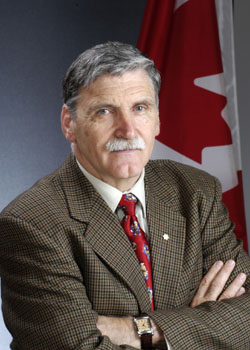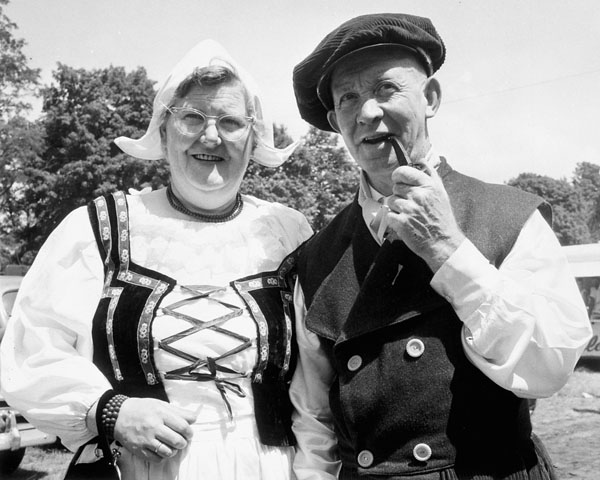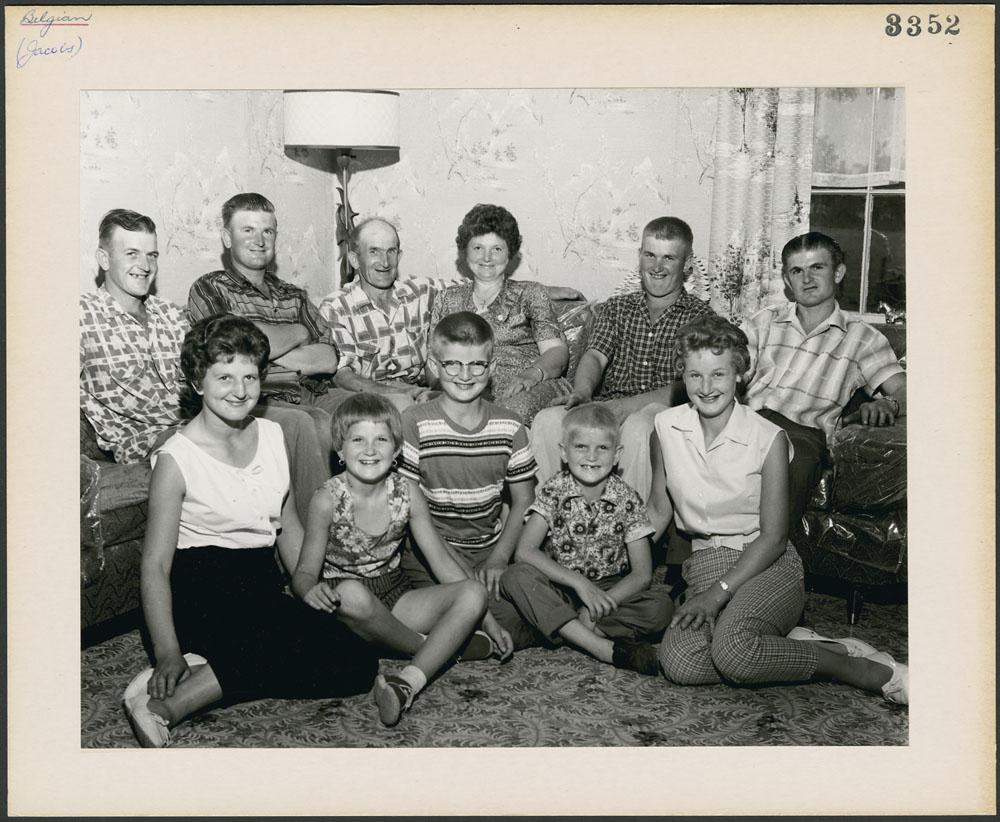From the earliest years of the 17th century, the Dutch were engaged in the fur trade on the Hudson River. In 1614, they established trading posts on Manhattan Island and at Fort Orange (present-day Albany, New York). But it was only after the American Revolution that Dutch immigration to British North America (now Canada) began. The Dutch who had long been settled in the Thirteen Colonies fit easily into Canadian society. Since that time, Canada has experienced three immigration cohorts from the Netherlands, the largest of them after the Second World War.
During the Second World War, the Canadian Army liberated a number of Dutch cities. Canada also provided refuge to the Dutch royal family. As a result, Canada and the Netherlands have enjoyed a close bilateral relationship ever since. The 2021 Canadian Census reported 988,585 persons of Dutch origin living in Canada.
Origins
In the 17th century, the Dutch arrived in North America and established the New Netherlands colony. However, it was not until the American Revolution that an indeterminate number of Dutch American Loyalists entered the British North American colonies. Already considerably anglicized, this group was quickly assimilated into the existing society and masses of immigrants who came after 1815.
Because of economic and social pressures, emigration from the Netherlands grew rapidly in the mid-century and in the following decades. Many Dutch immigrants aimed for the rapidly developing American frontier.
When cheap arable land became scarce in the United States by the 1880s, the Dutch and Dutch Americans turned to the Canadian “Last Best West.”
Migration History and Settlement
The Dutch have settled in Canada in three main periods. During the first, from 1890 to 1914, Dutch immigrants joined the migration to the Canadian West to take up homestead and railway lands. They helped open the Prairies and established ethnic settlements such as New Nijverdal (now Monarch, Alberta), Neerlandia (Alberta) and Edam (Saskatchewan). The majority of the immigrants were scattered across the West either as farmhands or as farm or ranch owners. Some settlement concentrations did occur, however, particularly in and around Calgary, Edmonton and Winnipeg. Indeed, Winnipeg probably had the largest Dutch community in Canada prior to the First World War.
The second period of immigration, from 1920 to 1929, ended with the coming of the Great Depression. Cheap, accessible arable land was now in shorter supply. However, the demand for farm, construction and industrial labour as well as domestic service was high. This was particularly the case as the postwar recession came to an end. Dutch immigrants moved quickly to take up these opportunities across Canada, particularly in Ontario and the Western provinces. During this period, significant concentrations of Dutch immigrants settled in southern and southwestern Ontario, especially in Toronto. It is estimated that between 1890 and 1930 approximately 25,000 Dutch or Dutch American immigrants entered Canada.
The Great Depression and the Second World War curtailed Dutch immigration until 1947. After the war, tens of thousands began to flee from their war-devastated and economically ruined homeland. Initially, the immigrants, as in the past, came from the agricultural sectors. By the mid-1950s, however, they included many skilled and professional workers. Ontario became a particularly important destination, followed by Alberta, British Columbia and the Maritimes. After the Second World War, Canada paid for the passage of nearly 2,000 Dutch war brides and their children.
By the late 1960s, some 150,000 Dutch immigrants were well-established in all provinces (with the exception of Newfoundland. This was particularly the case in Ontario and the urban areas of the Western provinces. These communities served as beacons of welcome and attraction for later Dutch immigrants.
Social and Cultural Life
Historically, Dutch Roman Catholics formed the largest single religious entity. However, the combined population of Dutch Protestant groups outnumbered them. Among these Protestants, the Christian Reformed Church (CRC) was the most prominent on the Canadian religious scene The CRC was especially present in Alberta, British Columbia and Ontario, where it had many communities. There are several other Dutch Calvinist churches in Canada, including the Free Reformed, Canadian Reformed and United Reformed Churches.
These various faith communities encouraged integration and the adoption of those things Canadian that were not antithetical to social or religious practices. As a result, the Dutch language has become less and less spoken. Moreover, some have abandoned “old country” practices that they believe could limit their economic outcomes. Integration combined with a strong work ethic and minimal past involvement in the cultural life of the native land, has meant that Dutch ethnicity only has a very personal, familiar or religious connotation for some. This, no doubt, helps to explain why Dutch-Canadian clubs represent no more than a minority of the Dutch community. Only recently have the children and grandchildren of immigrants begun to examine the history of their parents' or grandparents' migration and struggle, and to give their discoveries academic or literary form.
Group Maintenance
The Dutch in Canada have until recently expressed little interest in maintaining or continuing their cultural traditions. The major exception is the Dutch Calvinists. The latter have sought to make their religious philosophy relevant to Canadian society by developing “Christian” organizations and schools. The rate of integration among first-generation immigrants is very high and assimilation is almost complete in Canadian-born Dutch. In the 2021 Canadian Census, 88,970 people reported Dutch as their mother tongue. This is significantly lower than in 2016, when this number was at 104,505.
While family ties remain strong, intermarriage with other Canadians is not regarded as a problem by the majority. The Calvinist Church, the Dutch Credit Union and the Dutch-Canadian clubs, which represent only a minority of Dutch Canadians, are the only remaining visible landmarks of an ethnic culture that is rapidly and willingly disappearing into the Canadian multicultural state.
While family ties remain strong, intermarriage with other Canadians is not regarded as a problem by the majority. The Calvinist Church, the Dutch Credit Union and the Dutch-Canadian clubs, which represent only a minority of Dutch Canadians, are the only remaining visible landmarks of an ethnic culture that is rapidly and willingly disappearing into the Canadian multicultural state.
Notable Dutch Canadians
Many Canadians of Dutch origin have distinguished themselves in the arts, including painter Cornelius Krieghoff, composer and conductor Allard De Ridder, photographers John Vanderpant and Kryn Taconis, film director Patricia Rozema, actress Sonja Smits and author Aritha Van Herk.
Many other Dutch Canadians have played important roles in education (Egerton Ryerson, descendant of a family of Dutch-American Loyalists), government (Samuel Holland), business (Sir William Cornelius Van Horne), politics (Bill Vander Zalm, Simon de Jong, Rick Dykstra, John Van Dongen and Elizabeth Witmer), human-rights advocacy (Roméo Dallaire) and sports (Joe Nieuwendyk, Trevor Linden, Greg de Vries, Jeff Beukeboom and Steve Yzerman).
Bilateral Relations between Canada and the Netherlands
Canada and the Netherlands maintain a dynamic bilateral relationship. The link between the two countries draws strength from the Second World War. During the war, Canada provided refuge to the Dutch royal family. In June 1940, the Germans conquered the Netherlands. As a result, the Dutch royal family fled to Canada. They remained there until the end of the war. During her stay in Ottawa, Princess Juliana gave birth to a third daughter, Princess Margriet Francisca, at the Ottawa Civic Hospital. The Canadian government temporarily declared the hospital’s maternity ward extraterritorial land so that the new princess would hold only Dutch (and not Canadian) citizenship. This allowed Princess Francisca to remain eligible to the Dutch throne when she grew up.
Canadian forces also played a major role in liberating the Netherlands. In the fall of 1944, a few months after the Allied landings in Normandy on D-Day, the First Canadian Army battled the German forces along the Scheldt Estuary in northern Belgium and the southwestern part of the Netherlands. The Canadians aimed to open the Belgian port of Antwerp to Allied shipping. However, the Battle of the Scheldt caused heavy losses: more than 6,300 Canadian soldiers were killed, wounded or captured. In March 1945, as the Allied forces began pushing the Germans back across the Rhine into Germany, the Canadian First Army undertook the liberation of the Netherlands. In the cities of The Hague, Rotterdam and Amsterdam, the Dutch people gave the Canadians a joyous welcome. The German forces in the Netherlands surrendered on 5 May 1945 (see also Canadian Soldiers and the Liberation of the Netherlands).
Every year since the war, the Dutch have sent Canada 20,000 tulip bulbs as a gesture of thanks for liberating their country and providing refuge to their royal family. This tradition is the source of the Canadian Tulip Festival which has been held annually in Canada’s National Capital Region since 1953 (see National Capital Commission). The memory of the Canadian soldiers who fell in combat is honoured at a number of military cemeteries in the Netherlands, in particular the Holten and Groesbeek Canadian War Cemeteries. The ties between the two countries are also expressed by the participation of several teams from the Canadian Armed Forces in the International Four Days Marches in Nijmegen every year.
In 2023, the Netherlands represented the second-largest immediate source of foreign direct investment in Canada. The Netherlands is also one of Canada’s main partners in trade and innovation. In 2023, the Netherlands was Canada’s largest export destination in the European Union. Exports to that country were worth $7.55 billion. Meanwhile, Canadian imports of Dutch goods were valued at $5.96 billion. Through the Canada-European Union Comprehensive Economic and Trade Agreement, the two countries have also removed many trade barriers and encouraged free trade.
Many Canadian and Dutch companies and institutions collaborate on innovative projects in areas such as urban planning, universal health services, agriculture and green energy. For instance, researchers from both countries have worked together through the Netherlands-Canada Type 2 Diabetes Research Consortium.

 Share on Facebook
Share on Facebook Share on X
Share on X Share by Email
Share by Email Share on Google Classroom
Share on Google Classroom






































